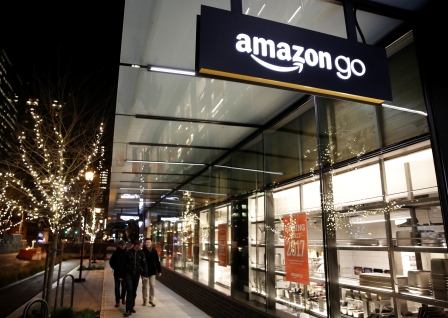How Amazon Go Will Break The Grocery Industry
— December 9, 2016
On Monday, December 5th, Amazon surprises us, yet again, with another break-through innovation. It’s called Amazon Go and it’s launching its first flagship store in Seattle early next year. Visitors will be able to pick up the items they need and virtually “walk out” without a cashier, line or check out process.
While many grocery or supermarket retail brands are still relying on outdated customer feedback programs via receipts and traditional loyalty cards for customers’ wallets, Amazon sets the bar high on another level regarding customer service. In this blog post, I’m going to divulge how the grocery industry can move from traditional practices to more contemporary ones. Instead of viewing Amazon as an insurmountable, unattainable force to mimic, rather see Amazon as an inspiring technology leader to reflect similar practices for your business. There’s always room to take on a share of the new mobile economy. Amazon just knocked down that brick wall, so push through the rubble to see what promise lies beyond.
Here are three key takeaways for supermarkets (and really any retailer) on ‘Amazon Go’ and Amazon’s mobile strategy in general. Take these tips as action items for starting or improving your mobile strategy.
1. Think Differently & Take Risks
Amazon positioned their brand based on a technology that was once defined as a taboo. It’s called online shopping and now most of us have done it at some point. They broke all the rules in the retail industry. Some saw Amazon as a pioneer while others saw them as a threat to tradition. But it took them grit, time and growing pains before capitalizing. Taking the first step into a new venture is always the hardest. The risk, the change, or the fear of failing and losing money sets back most businesses from even trying. But sometimes businesses have to spend/invest money in order to make money in the long run. Shockingly, there was even a time when Amazon wasn’t profitable.
Takeaway: Take risks as a supermarket business. The grocery industry is still very traditional and the typical means of communication and loyalty don’t even touch upon mobile. So start small. Do a trial or beta test. Save aside a small or modest budget for mobile development and marketing. If you already have an e-commerce or online webshop, you might find it easier to move into mobile commerce. There are plenty of capabilities mobile commerce offers that web doesn’t. Likewise, there are also some interesting mobile engagement opportunities that the supermarket industry could do with mobile. Just take that first step.
2. Obsess About Smart Personalization & Segmentation
What makes Amazon so successful is that they spearhead personalization to the max. With options to see recommendations and similar products other shoppers have bought, Amazon puts their customer data to use. They do smart segmentation and profiling while indexing products based on deep-learned algorithms. Such algorithms evaluate customer history, customer preferences, recommendations, customer search terms, items bought and more. Translating this e-commerce customer data into the mobile channel (m-commerce) also reveals new metrics as well. New metrics on mobile include mobile site opens, app openings, time spent, screens/pages viewed, products saved, coupons redeemed/used, stores visits (enabled by beacons) among other metrics.
Takeaway: Embrace smart profiling, segmentation, and personalization. For example, start off by offering your customers a curated shopping list. Based on user historical searches on products viewed or searched, set up beacons in the shop. When a user enters the shop, enabled by beacon triggers, send them a friendly in-app message and tell them where that item is located.
3. Transition Your Web Strategy to a Mobile Strategy Fluidly
Mobile traffic overtakes desktop traffic substantially. “Mobile browser traffic increased by an impressive 1.78% during November,” according to Sitepoint, and this number is increasing on a monthly basis. And time spent on mobile apps exceeds desktop (90%) according to ComScore. While Amazon still has an impressive web presence in a thriving e-commerce site, they still have an accessible mobile site and multiple apps to sustain their brand image and transactions on all channels.
Takeaway: Transition to mobile now. Moving from a web strategy to a mobile-first strategy is vital to surviving, let alone profiting in the constant interruption of new technologies in business.
Want to learn more about mobile commerce, but don’t know how to get started? Download our m-commerce brief and get a quick overview what it entails and why it matters for your bottom line.
Business & Finance Articles on Business 2 Community
(30)













